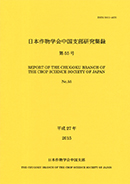Volume 44
Displaying 1-17 of 17 articles from this issue
- |<
- <
- 1
- >
- >|
-
Article type: Cover
2003Volume 44 Pages Cover1-
Published: September 05, 2003
Released on J-STAGE: January 30, 2018
Download PDF (16K) -
Article type: Index
2003Volume 44 Pages Toc1-
Published: September 05, 2003
Released on J-STAGE: January 30, 2018
Download PDF (49K) -
Article type: Article
2003Volume 44 Pages 1-
Published: September 05, 2003
Released on J-STAGE: January 30, 2018
Download PDF (180K) -
Article type: Article
2003Volume 44 Pages 2-21
Published: September 05, 2003
Released on J-STAGE: January 30, 2018
Download PDF (2286K) -
Article type: Appendix
2003Volume 44 Pages 22-24
Published: September 05, 2003
Released on J-STAGE: January 30, 2018
Download PDF (305K) -
Article type: Appendix
2003Volume 44 Pages 25-27
Published: September 05, 2003
Released on J-STAGE: January 30, 2018
Download PDF (173K) -
Article type: Index
2003Volume 44 Pages 28-53
Published: September 05, 2003
Released on J-STAGE: January 30, 2018
Download PDF (2656K) -
Article type: Index
2003Volume 44 Pages 54-64
Published: September 05, 2003
Released on J-STAGE: January 30, 2018
Download PDF (1073K) -
Article type: Article
2003Volume 44 Pages 65-78
Published: September 05, 2003
Released on J-STAGE: January 30, 2018
Download PDF (1665K) -
Article type: Article
2003Volume 44 Pages 79-84
Published: September 05, 2003
Released on J-STAGE: January 30, 2018
Download PDF (670K) -
Article type: Article
2003Volume 44 Pages 85-90
Published: September 05, 2003
Released on J-STAGE: January 30, 2018
Download PDF (573K) -
Article type: Appendix
2003Volume 44 Pages 91-
Published: September 05, 2003
Released on J-STAGE: January 30, 2018
Download PDF (51K) -
Article type: Appendix
2003Volume 44 Pages 92-
Published: September 05, 2003
Released on J-STAGE: January 30, 2018
Download PDF (55K) -
Article type: Appendix
2003Volume 44 Pages 93-
Published: September 05, 2003
Released on J-STAGE: January 30, 2018
Download PDF (54K) -
Article type: Appendix
2003Volume 44 Pages 93-
Published: September 05, 2003
Released on J-STAGE: January 30, 2018
Download PDF (54K) -
Article type: Appendix
2003Volume 44 Pages 94-95
Published: September 05, 2003
Released on J-STAGE: January 30, 2018
Download PDF (86K) -
Article type: Appendix
2003Volume 44 Pages App1-
Published: September 05, 2003
Released on J-STAGE: January 30, 2018
Download PDF (16K)
- |<
- <
- 1
- >
- >|
